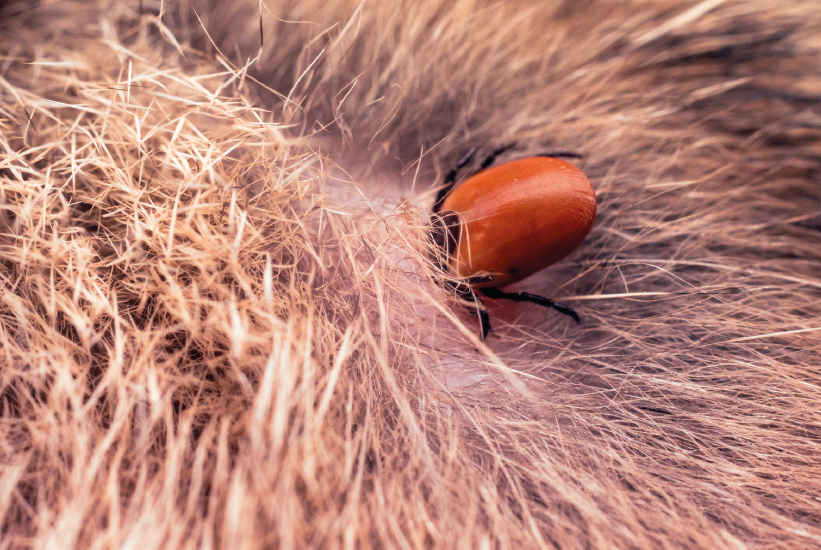Removing ticks from cats
Cats that are allowed outside should be checked regularly for ticks. Because the longer the parasites remain on the cat, the higher the risk of disease transmission. We will show you how to remove ticks properly.
What types of ticks affect cats?
The castor bean tick (Ixodes ricinus) and the meadow or marsh tick (Dermacentor reticulatus) are two very common types. In addition, the brown dog tick is occasionally found on cats. Ticks can be recognised by their brownish, oval body, their eight legs and their prominent stinging apparatus. In their normal state, ticks are about three to six millimetres in size, but when full of blood, a female can grow to almost three centimetres. However, they are not always so easy to recognise. In their developmental phase from the egg to the larva and nymph stages, they are a mere one to three millimetres in size.

Why are ticks dangerous?
The tiny amount of blood sucked up by a tick is not a concern for cats. Far more problematic are the diseases that ticks can transmit. They do not carry these from birth, but acquire them from host animals. At each stage of their development, the parasites look for a new host and migrate, for example from a mouse via a hedgehog to a cat. If neither the mouse nor the hedgehog was sick, the cat has nothing to fear. If, however, any of the host animals were carrying a pathogen, the tick may have ingested it while feeding on the animal’s blood and then transmitted it on. Potential diseases include Lyme disease (Borreliosis), anaplasmosis and ehrlichiosis.
Which cats are particularly at risk?
If you have an indoor cat, you do not have to worry too much about ticks. Ticks tend to lurk in tall grass, on bushes and in woods and forests. This is why cats that are allowed outside in rural areas are most at risk. The blood suckers can be expected from spring until late autumn; only in winter are they less likely to be found. They are able to detect potential hosts through their vibrations, their scent and the CO2 content in their breath. If the cat wanders close enough by, they drop down and claw themselves into position. Then they start looking for a suitable place to bite. They prefer areas with thin skin, a ready supply of blood, and less dense fur. If, However, they are disturbed here, they will move to a spot (such as the neck) that the cat cannot reach.
What tick protection is there for cats?
Cats cannot be protected from tick bites by means of vaccinations. But there are medicinal products available that can be used locally. Tick collars or spot-on products are suitable for this purpose. Collars have to be worn at all times to ensure protection against ticks. One disadvantage of the tick collar is the risk of the cat getting caught up in trees or bushes. For this reason, most cat owners opt for a spot-on product. The liquid is applied directly to the skin of the cat’s neck so that it cannot be licked off. It is automatically spread over the cat’s body and acts as a repellent. This normally deters ticks from biting in the first place. It remains effective for several months, depending on the product.
Tip: Never rely entirely on a tick repellent, because it will still be possible for your pet to bring ticks into your home. It is therefore best to check cats who are allowed outside on a regular basis.
How can I remove a tick from my cat?
Sooner or later, every cat that is allowed outside will be bitten by a tick. In fact, most cats are regularly attacked by these parasites. Then you have to react as quickly as possible. It is best if you are able to catch the tick before it bites your pet. No disease transmission will have then been possible. However, if the tick has already bitten you cat, then it is important to remove it immediately. Do not use oil, nail varnish or glue for this, because the tick will cling on to the cat‘s skin even more firmly before it dies, possibly releasing even more saliva into the bite, which could be infected. Make sure that you only use special tick removal tweezers or a tick hook.
Use the following procedure to remove a tick:
- Move the hair surrounding the tick to the side to avoid pulling out your cat’s hair wherever possible.
- If your cat will not keep still, ask someone to help you.
- Place the tick removal tweezers as close as possible directly on the cat’s skin.
- As soon as you have a firm grip on the front body of the tick, slowly start to pull.
- Gradually pull more strongly and wait.
- The tick will normally be released after a few seconds.
- If not, be patient and enhance the pulling action by twisting gently.
- Crush the removed tick between two solid objects (for example household tissues or paper handkerchiefs) or secure it with adhesive tape, which you can then throw in the waste bin.
If the tick has been torn apart, observe the position of the bite. If the head remains stuck in the skin, this is usually not a problem as it will become inactive. If the site of the bite becomes infected or if the cat develops symptoms such as vomiting, a high temperature, faintness or seizures, please consult a vet immediately.
You may also like this

Feeding your cat
Tips on food and a healthy diet

When a cat keeps scratching itself
Possible causes if your cat keeps scratching itself

Excess weight in cats
If a cat weighs too much, there is the risk of health problems

My cat isn’t drinking
Find out if your cat is not drinking enough
